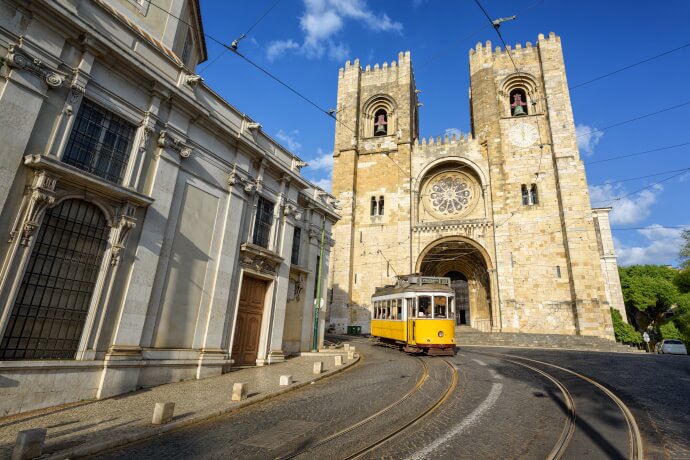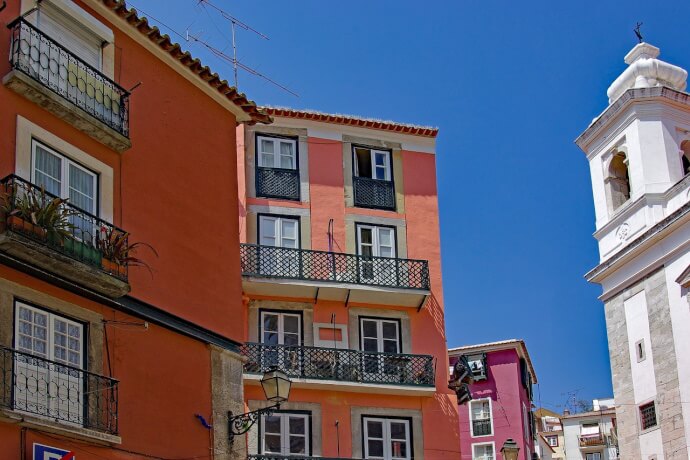As the starting point to most adventures in Portugal, Lisbon grips you right away with its eclectic collection of attractions that encompass the best there is in the country’s architectural, historical, cultural, and even environmental heritage. Ranging from outstanding religious buildings to lively neighbourhoods graced by the sorrowful melodies of Fado, the capital’s streets are a never-ending adventure across a well-rounded and multi-faceted identity.
Let your mind peruse along the winding narrow streets of this timeless destination, while we help you unveil Lisbon’s most iconic places. With this list, your next adventure to Portugal’s magnetic capital will be filled with excitement!
Sé
As the oldest church in Lisbon, the Sé is an unavoidable site to include in your trip to the capital. With its foundations laid during the reign of D. Afonso Henriques around 1147, the cathedral’s history has walked over 800 years of change, evolution and even devastating destruction with the earthquake of 1755. What we see today results from reconstruction and restoration works in the 18th and 20th centuries.
As you stand before this grandiose religious space, you are confronted with its architectural might, featuring the influences of the original Romantic and Gothic styles blended with the more exuberant Baroque movement. Stepping inside, the solemn light coming through the rose window welcomes you into the serenity of faith and religion complemented by an intricate vaulted ceiling.
In this iconic site, the Treasury of the Patriarchal See is a top attraction, advantaged by an ensemble of valuable religious artwork. The cloister excavations, in their turn, shed light into the storied past of this site and its perseverance through time!
Alfama neighbourhood
From history, we move on to music and tradition. The beating heart and soul of Lisbon are splattered along the narrow, winding cobblestone streets of Alfama, a picturesque neighbourhood bustling with the identity of its people and the transporting Fado music.
Settled by the Romans and the Visigoths and named by the Moors as “al-hamma”, this picturesque quarter has grown into a charismatic spot alluring to music enthusiasts and eager photographers seeking to capture its vibrantly-coloured buildings. Built outside the walls of São Jorge Castle, this iconic place is equally close to some of the city’s main highlights, namely the Sé de Lisboa and the National Pantheon.
Today, Alfama beckons tourists to its quarters with its typical fado houses and the museum dedicated to this specific musical style. According to history, this very neighbourhood is the birthplace of the melancholic Fado music. Hence, there is no better place to listen to live performances than right here!
Miradouro de Santa Luzia is one of the top sites to soak in the prime location of this vibrant neighbourhood facing the Tejo River. Decorated with blue-coloured tiles, this spot will immerse you even further in Lisbon’s riveting beauty.
Carmo Convent
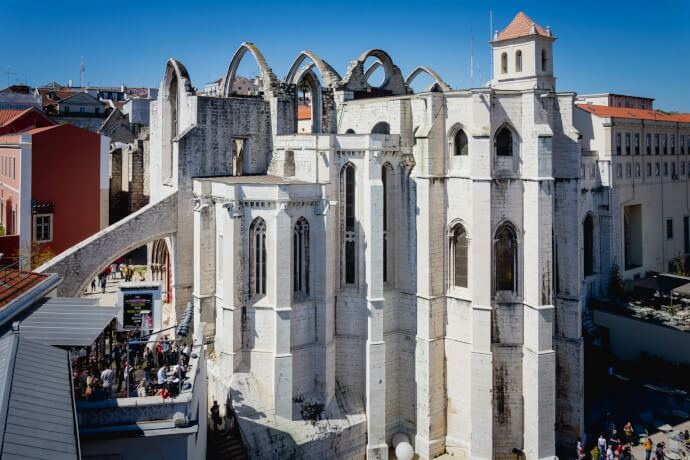
If you are looking to unearth Lisbon’s top iconic places, then the Carmo Convent must be included in your list. Founded by D. Nuno Álvares Pereira, a faithful knight of King D. João I, this imposing Gothic-style monument reflects the unbreakable religious dedication of its creator.
Even though a great part of the original structure was destroyed in the earthquake of 1755, Carmo Convent’s Gothic arches have persevered through time, alongside most of its religious art, now on display at the archaeological museum inside this former convent. Here, you will find relics donated by specialists in the field in the 1800s. Some of the treasures include the tombs of King Ferdinand I and Queen Maria Anna of Austria, as well as an Egyptian mummy.
Mostly in ruins, the Carmo convent stands as a poignant reminder of its past and the city’s evolution. Its skeletal remains transport you to the bygone eras of its founder and whispering prayers of those who visited this former religious space.
Oceanarium

Lisbon’s aquatic gem bursting with vibrant marine life is located in the modern Oriente neighbourhood. Known as ‘Oceanário’, this institution is a world-class public aquarium, home to over 8,000 sea animal species and 450 different kinds of plants that take you on a voyage through the depths of the ocean and the extreme climates of the poles, where penguins and otters thrive!
Interactive displays, fantastic exhibits and an enormous central fish tank use educational presentations to help guests of all ages develop a greater understanding of marine preservation and the importance of the ocean to the preservation of the ecosystems. In the end, appreciating the natural beauty of nature is the igniting point to spreading awareness and care across generations.
Emerging from this underwater paradise, where you have the chance to touch noses with the sharks, smile at the stingrays and witness the otters’ joyful swims, will make you feel ever so close to nature and its oftentimes feared species.
Jerónimos Monastery
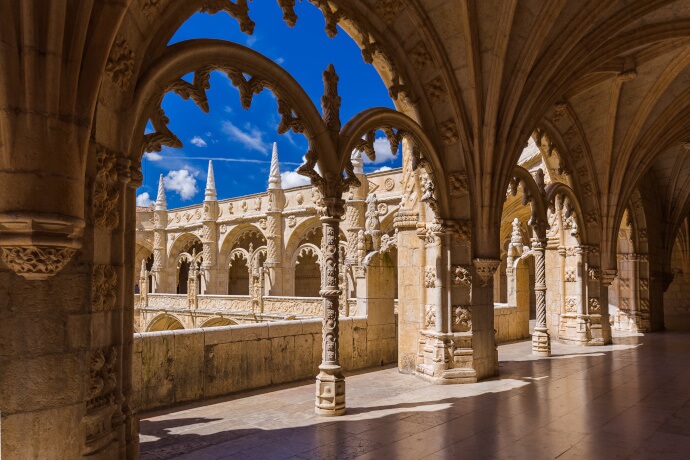
On the opposite end of Lisbon, in Belém, stands the majestic Jerónimos Monastery. This UNESCO World Heritage Site finished in 1601, is the embodiment of the Portuguese Manueline architecture, a style inspired by the Age of Discoveries and its connection with the unknown seas.
Also known as the Portuguese Late Gothic, this movement combines elements of the Gothic, Renaissance and Moorish periods blending it with maritime motifs. Pay special attention to the monument’s façade adorned with the statue of Prince Henry the Navigator which showcase a prime example of how this style was incorporated into the monastery.
Beyond the exterior grandeur, Jerónimos dazzles with its interior stone arches and chapels dedicated to different saints. In these spaces, visitors can also encounter the tombs of the great explorer Vasco da Gama and the writer Luís de Camões.
As a coveted space in Lisbon, the monastery is best visited during the week in the off-peak season, avoiding public holidays.
Santa Justa Lift
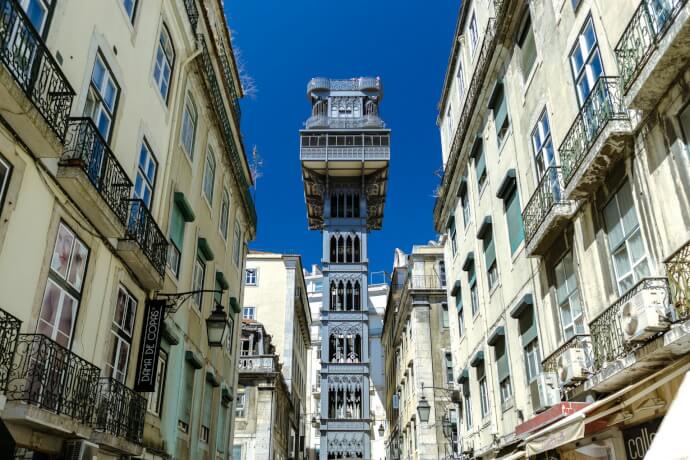
In 1902, the then-called Carmo Lift was inaugurated as part of the city of Lisbon’s transport system. Connecting the popular Baixa and Bairro Alto neighbourhoods, this iron-built elevator has become one of this destination’s most iconic symbols inspired by the style of the French architect Gustave Eiffel.
Carrying up to 20 people, the Santa Justa lift elevates you to a different, mesmerising point of view over Lisbon. The magnificent vistas of the “Baixa” and the city’s scape make you fall even more in love with the picturesque character of this enchanting city planted by the banks of the Tagus River.
Set amidst the city’s busy streets, the vertical lift of Santa Justa authored by Mesnier du Ponsard captivates you with its views and its intricately detailed wrought-iron tower also ornamented with filigree work.
Lx Factory
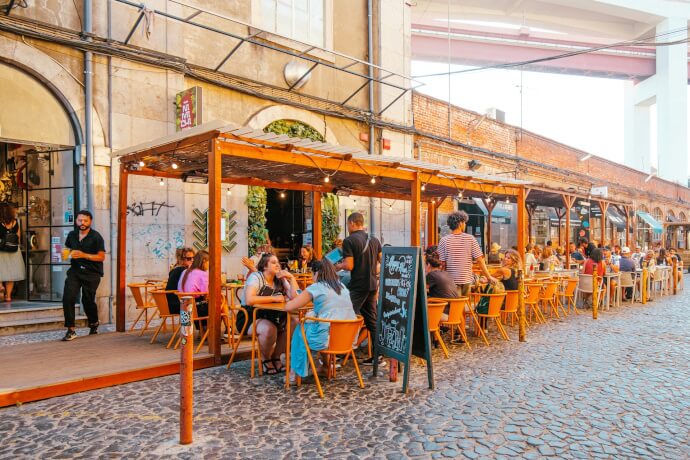
Modern and laid-back, Lx Factory is an encapsulated materialisation of contemporary Lisbon. With an industrial outlook where once stood the 19th-century Company of Wiring and Fabricos Lisbonense, this space has become a trendy location where the creativity and artistic ingenuity of the new generations come to life.
Now revitalised as Lx Factory, this hotspot mimics a village with the intent to welcome visitors into a transporting, welcoming reality of street art, old warehouses, cafés and restaurants exuding the most delicious aromas. Art, design, literature, fashion and music have here a home to thrive as inquisitive pieces.
For years this gem concealed in Alcantara stood under the radar of the local citizens and tourists, today it has become part of Lisbon’s most iconic places to visit!
National Tile Museum
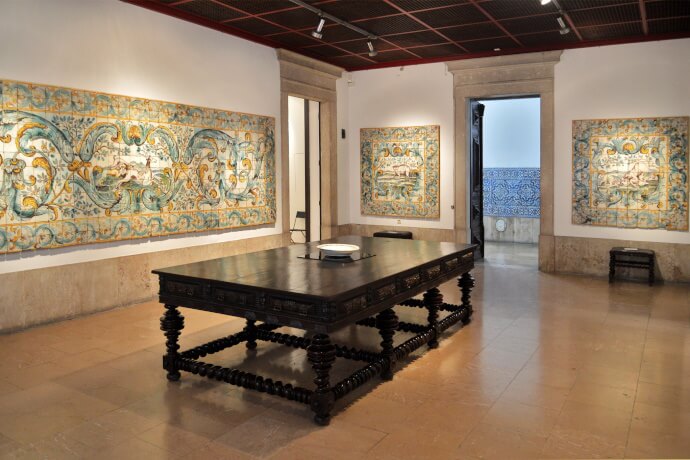
A visit to Lisbon’s icons would be incomplete without the National Tile Museum. Formerly the Convent of Madre de Deus, this venue showcases a comprehensive collection of tiles from the 15th century up to the 1900s. As you meander through the permanent exhibition, you are confronted with the cultural impact of this decorative element on the country’s cultural heritage and identity.
Between the vivid blue hues and contrasting white, depicting religious scenes following the Baroque and Rococo styles, you will find in this venue a true pièce de resistance - a set of panoramic tiles illustrating the beautiful medieval town of Lisbon before the earthquake of 1755.
In the end, the National Tile Museum helps you make sense of the city’s singular architecture embellished by the traditional azulejos, which have travelled through time and history!
Comércio Square
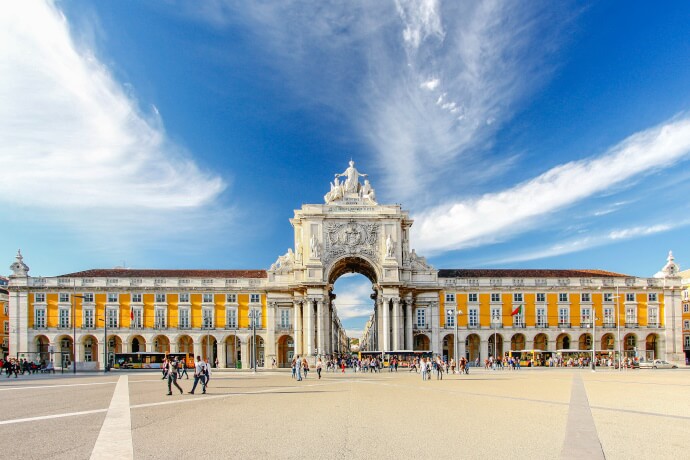
If you walk from Rua Augusta, the cobblestone ample street and its dazzling arch will reveal to you another icon, the Praça do Comércio. This square, also known by many as Terreiro do Paço, is a lively place, once pivotal to the monarchy and the Discoveries as the house of the Royal Palace and the quay where the ships departed and arrived.
Built in the 18th century, the site shares a glimpse into a neoclassical-inspired symmetry of proportional yellow buildings and arches that today house trendy restaurants, ministries and government offices. Right at the centre, you will be confronted with the equestrian statue of King D. José I from 1775.
Throughout the year, Comércio Square is a lively gathering place, which hosts events and celebrations, such as the New Year’s and the Holiday Season with an iconic Christmas tree lit in late November.
A city of wonders
Just like peeling the back layers of an onion, each iconic place in Lisbon reveals to you a different and even more intriguing aspect of this destination’s cultural and historical heritage. The capital’s treasure trove of religious spaces, artistic venues and natural wonderlands add an extra allure to a coveted location visited by thousands of tourists every year. Truth is, between Lisbon’s charming Alfama neighbourhood, subverting Lx Factory or traditional ceramic tiles, you will find an authenticity like no other that makes up a well-rounded, complex identity.
Are you ready for a Portuguese adventure that will stay with you forever?


